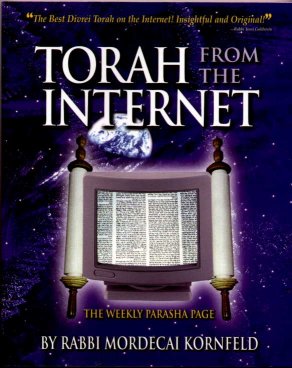
More Parasha-Pages |
Weekly Parasha-Page |
 Ask a Question |
Simchat Torah 5755HA'BERACHAH (a.k.a. SIMCHAT TORAH)It is my pleasure to share with you a piece of liturgical research by my friend and mentor, Dr. Norman Bloom. Dr. Bloom does research on the history of the Jewish prayerbook and Torah readings, among other subjects, which he periodically publishes in various Judaic publications. When not involved in an exciting piece of original research, he is a practicing urologist in North Miami Beach, Florida.
ITo appreciate this, one must first examine the custom of completing the Torah reading of the year on the final day of Succot (i.e., Shemini Atzeret). In contrast to more ancient times -- when the Jews of Eretz Yisrael adhered to a triennial cycle -- this practice, upon which the name Simchat Torah is based, is now universal. In spite of this universality, the minhag does raise some valid questions:
IIThe second question, however, is more difficult to answer. Though primary sources are virtually nonexistent, a plausible explanation may, nevertheless, be developed. Note must be first taken of the theme that is common to the three parshiyot immediately following Ki Tavo, i.e. Nitzavim, VaYelech and Ha'azinu. They all touch in greater or lesser measure on the concept of teshuva, which makes them particularly appropriate for reading during the Ten Days of Repentance. The first available Shabbat, therefore, for V'zot Haberachah had to be the Shabbat after Yom Kippur. During most years this would be the one before Succot, but in years when Yom Kippur itself falls out on Shabbat, the first "free" Shabbat would be after Succot. Though less than desirable because its lack of uniformity, this arrangement might have become the custom, had not another dictum of Chazal that had to do with the parsha of V'zot Haberachah itself supervened. The Talmud (Megilah 31a), in recounting the Torah readings for all the Yomim Tovim (holidays) of the year, specifies that V'zot Haberachah is to be read on the second day of Shemini Atzeret. Though generally understood as also implying that the Torah reading cycle was to be concluded at this time, another equally plausible explanation may be presented, one that is consistent in intent with all the other holiday Torah readings that were selected for their relevance to the theme of the Yom Tov. So too, the Gemara was choosing V'zot Haberachah (and not the entire parsha, but rather its first segment) to be read on the second day of Shemini Atzeret because it, too, accentuates the theme that is appropriate for the day. Several Rishonim (e.g. R. Simcha of Vitry, R. Avraham Ha'Yarchi [Sefer Hamanhig], and Abudraham) take this approach only in part. Though they appear to be of the opinion that the Gemara did indeed intend for the reading cycle to be finished on Shemini Atzeret, each also calls upon the same historical event -- the dedication of the newly built first Beit Hamikdash -- to offer an alternate explanation as well. The dedication took place during the holiday of Succot, and it was on the eighth day of the holiday, i.e. Shemini Atzeret, that Shlomo Hamelech (King Solomon) blessed the throngs of Israelites that had gathered in Jerusalem for that joyous occasion (I Kings 8:53,54). It is partly for this reason, the Sefer Hamanhig explains, that "on...the ninth-safek Shemini Atzeret... all of Israel reads V'zot Haberachah, because Shlomo Hamelech blessed Israel on... [that day]... therefore [on that day]..we [also] read ...the blessing that Moshe Rabbeinu blessed Israel." In actuality, the story of Shlomo's blessing, documented in the above chapter of the book of Kings, is the Haftarah for the first day of Shemini Atzeret. This presents an almost unique phenomenon. It is the accepted norm that the Torah reading is considered primary and the Haftarah secondary. On Shemini Atzeret/Simchat Torah, these roles have been reversed. Chazal, wishing to highlight the theme of blessing for this Yom Tov -- thus the erstwhile name of Yom Haberachah -- may have chosen the Haftarah first, and only then selected the Torah reading to accentuate further this theme of blessing! Reading V'zot Haberachah on the second day of Shemini Atzeret, even if originally it was only the first twenty nine verses that contain the brachot, of course, presented the golden opportunity eventually to read the parsha to its very end -- and thus at the same time complete the Torah reading cycle on this day as well. It is not too difficult to imagine that in the course of time, this is exactly what happened, as Yom Haberachah gradually evolved into Simchat Torah. IIIOver the years, perhaps even starting with the time of Chazal themselves, this idea has been extended further, making this Yom Tov the climax for all the Yomim Tovim sof Tishrei, including the Yamim Noraim [High Holy Days] as well. Even today, this underlying motif, albeit muted, may be easily discerned in several customs of the Ashkenazic minhag (nusach Polin) that are peculiar to Simchat Torah.
Viewed from this perspective, Simchat Torah emerges as a multi-dimensional holiday, not simply centered around the annual Torah reading cycle being brought to its conclusion. Besides its Shemini Atzeret connection, it also has at least one other major theme -- that of a day suffused with an all encompassing aura of blessing. This makes the holiday into a particularly appropriate finale not only for Succot, but for the Yamim Noraim as well. These now end on a purposefully orchestrated upbeat note, giving over a clear feeling that our prayers have indeed been answered, and that a year of unbounded blessing lies in store for Klal Yisrael. The erstwhile name of Simchat Torah, "Yom Haberachah", well embodies this idea, and sensitivity to this should only serve to heighten our appreciation of this unique Yom Tov. | ||
